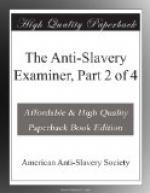[Footnote A: A fine of sixteen dollars for the first assault, and the liberation of the apprentice after a second.]
[Footnote B: Through the complaint of the apprentice to the special magistrate]
Barbadoes was not without its insurrections during slavery. Although not very frequent, they left upon the minds of the white colonists this conviction, (repeatedly expressed to us by planters and others,) that slavery and rebellions are inseparable. The last widely extended insurrection occurred in 1816, in the eastern part of the island. Some of the particulars were given us by a planter who resided to that region, and suffered by it great loss of property. The plot was so cautiously laid, and kept so secret, that no one suspected it. The planter observed that if any one had told him that such a thing was brewing ten minutes before it burst forth, he would not have credited the statement. It began with firing the cane-fields. A signal was given by a man setting fire to a pile of trash on an elevated spot, when instantly the fires broke out in every direction, and in less than a half hour, more than one hundred estates were in flames. The planters and their families, in the utmost alarm, either fled into other parts of the island, or seized their arms and hurriedly mustered in self-defence. Meanwhile the negroes, who had banded themselves in numerous companies, took advantage of the general consternation, proceeded to the deserted mansions of the planters, broke down the doors, battered in the windows, destroyed all the furniture, and carried away the provision stores to their own houses.
These ravages continued for three days, during which, the slaves flocked together in increasing numbers; in one place there were several thousands assembled. Above five hundred of the insurgents were shot down by the militia, before they could be arrested. The destruction of property during the rebellion was loosely estimated at many hundred thousand pounds. The canes on many estates were almost wholly burned; so that extensive properties, which ordinarily yielded from two to three hundred hogsheads, did not make more than fifteen or twenty.




